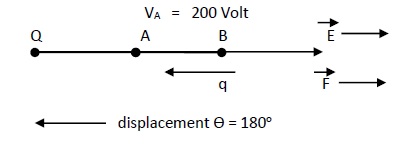Potential at a Point
Description:
So far we have studied potential difference between two points. If there are two points (A and B ) in an electric field such that potential of A is 200 volt. This implies that 200 joule of work is needed to be done to move a unit charge from B to A and hence the potential of A is 200 volt with respect to point B. The potential of a point is always decided with reference to the other pint.

We know that the potential goes on decreasing with increase in distance of the point from the charge (V = (1/4 πε0).q/r).
If the a point P is supposed to be at infinity, then the potential at P will be zero i.e no work will have to be done to move the charge from point P to A or point B. This point is called point at zero potential.
Proof of zero potential at ‘r = α’
We know that, electric field decreases with increase in distance of the point from the charge (V = (1/4 πε0).q/r2).
So, at r = α,electric field (E) = 0;
⇒ E = Force (F)* charge (q) = 0
But, q ≠ 0 ⇒ F = 0
So, at r = α no force is exerted on the charge.
We know,
Work done = Force * displacement
So, r = α,
W = 0.
dW/q = V = 0
So potential is 0 at infinity.
Let the distance of two points (A and B ) in an electric field be rA and rB respectively from the charge ‘q’.Let there is an another point ‘P’ at a distance ‘r’ where r = α , hence electric field and potential at P will be 0. As the charge is moved from P to B, at some point the electric field will be effective and will start to exert force (qE) in the direction of electric field (E) but, the displacement of charge is to be done against the direction of force. So, some amount of work is needed to be done for the displacement of charge.

Work done = potential at B – potential at P
WBP = VB - VP
⇒ WB α = VB - Vα
⇒ W = VB (Since Vα = 0)
Similarly if we move from P to B, some more work will have to be done, as the charge q will have to be moved to a greater distance rA
So,WAP = VA - VP
⇒ WAα = VA - Vα (Since Vα = 0)
⇒ W = VA
So, potential difference can be created into absolute potential of a point by taking potential difference between potential at that point and potential at α.
Method 2
Potential difference VA - VB = Q4πε0[1/rA-1/rB]
To convert potential difference to potential at point A, take point B to α
Then,VA - Vα = Q4πε0[1/rA-1/rB]
So, VA = 14πε0.qrA
VA is the potential at point A, which is at a distance rA from charge q.
Similarly;
VB = 14πε0.qrB
(when point A is at infinity)
Potential of a point − potential of a point in electric field is the amount of work done in carrying a unit charge from infinity to that point.
VA = WAαQ
Derivation
Expression for potential at a point
Q is a charge and A is a point are a distance ‘r’ . Let us take a general point P at distance ‘x’. A charge ‘q’ is moved by a small distance dx from P towards Q, then work done (dW)
dW = F * dxcos180;
dW = Qq dx(-1)4πε0x2
dW = -Qq dx4πε0x2
rA∫α dW = - Qq dx4πε0 rA∫α x-2dx
= -Qq dx4πε0[x-1-1]αrA
= Qq dx4πε0 [1rA - 1α]
WrA-αq = Q4πε0 1rA
So, Work done per unit charge will be −
WrA - αq = Q4πε0 1rA
This work done per unit charge gives the potential at point A
So, potential of a point at any distance ‘r’ is given by −
Vr = Q4πε0 1r
It is a scalar quantity.
Formula bank
1. VAB = WABQ
2. dV = - Edrcosθ
3. VA –VB = B∫A E.dl
4. VA – VB = Q dx4πε0 1rA - 1rB
5. Vr = Q dx4πε0 1r

